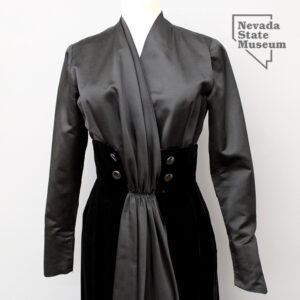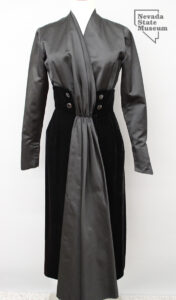September Curator’s Corner
Jacques Fath and the LBD
The color black has long been associated with mourning, religious, academic, legal, and ceremonial dress. But within the last 100 years, black has become a woman’s classic fashion choice. “The Little Black Dress” has saved many of us from the dilemma – “What to wear?”
The history of the little black dress is not necessarily of the color black, but rather the word, “little.” Black has long been associated with the voluminous garb mentioned above, including the somber fashions of the Victorian era. Streamlining the silhouette, reducing the garment to a street length, adding decolletage (neckline), and decreasing or eliminating sleeves dramatically changed its appearance. While no one knows the evolution of these changes, several fashion historians have attributed the LBD to Coco Chanel.
This beautiful Little Black Dress was donated to the Museum by longtime volunteer, Noreen Humphrey. It is a simple yet stunning, LBD, designed by French fashion designer, Jacques Fath. The dress is composed of two silk fabrics, satin for the surplice bodice and center front panel, while silk velvet was used for the raised waistband and the skirt. The center panel is a clever design, as it covers up the center front opening of the velvet skirt, which when moving, seductively opens to reveal the woman’s legs. Mrs. Humphrey wore this dress in 1949.
Fath presented his first collection in 1937 and worked until his death in 1954. He designed for such celebrities as Ava Gardner, Greta Garbo, and Rita Hayworth.

